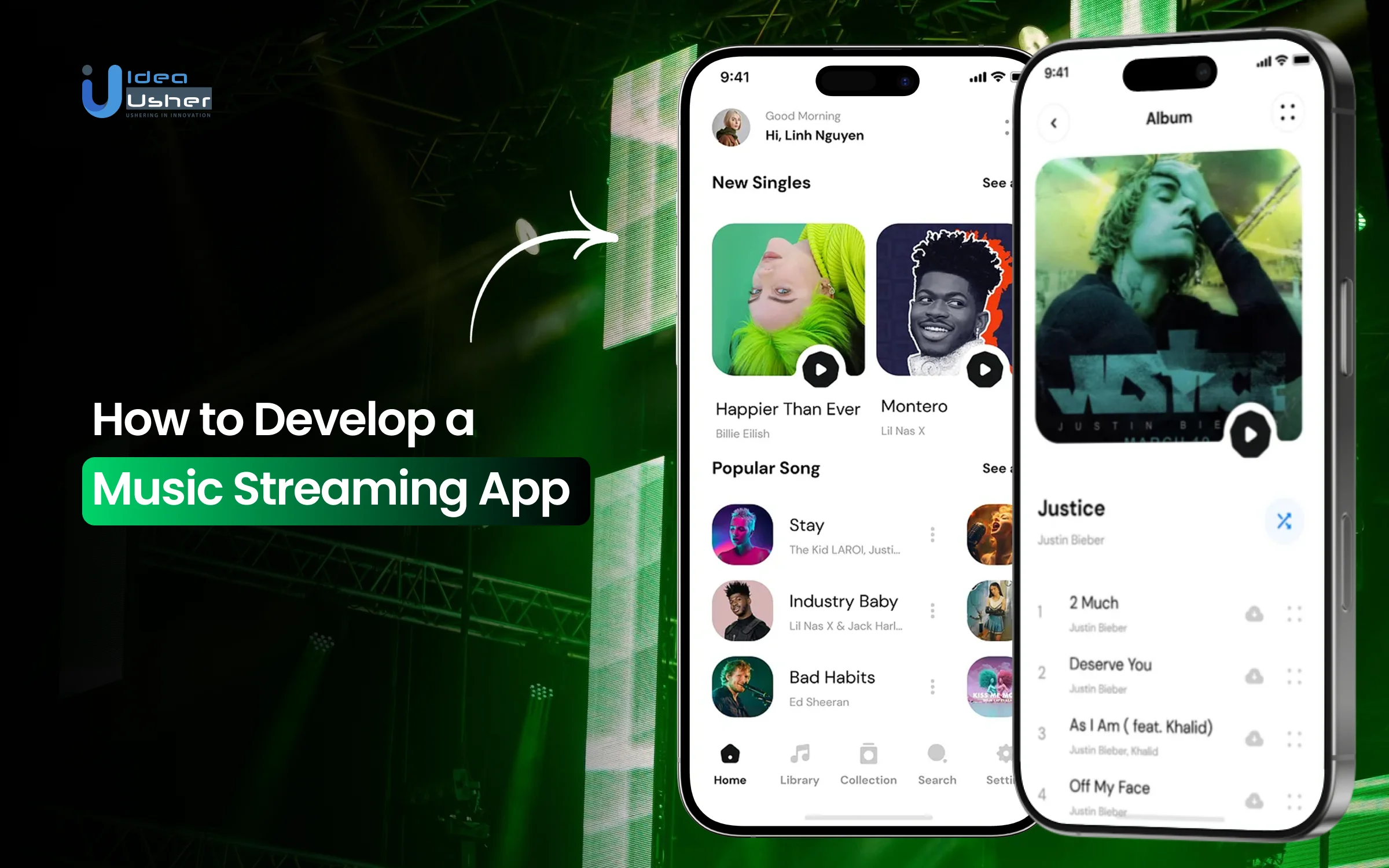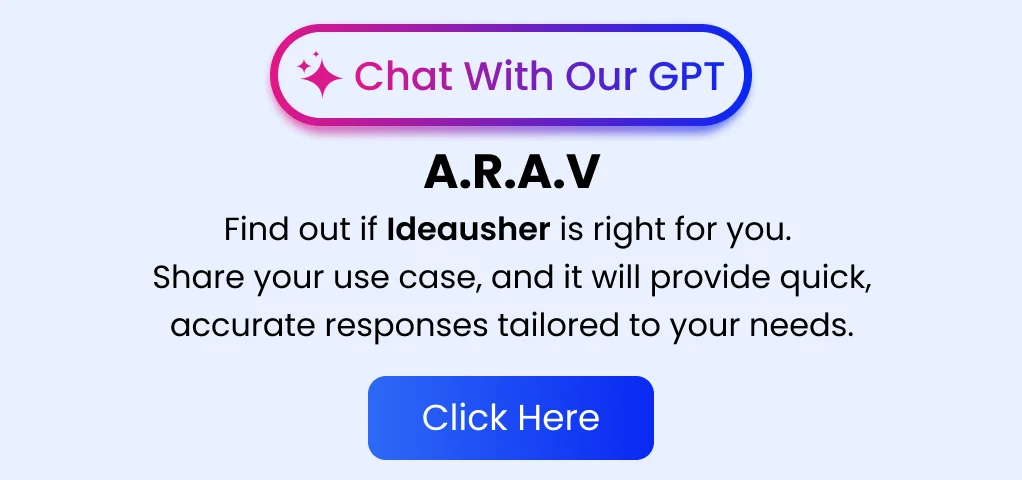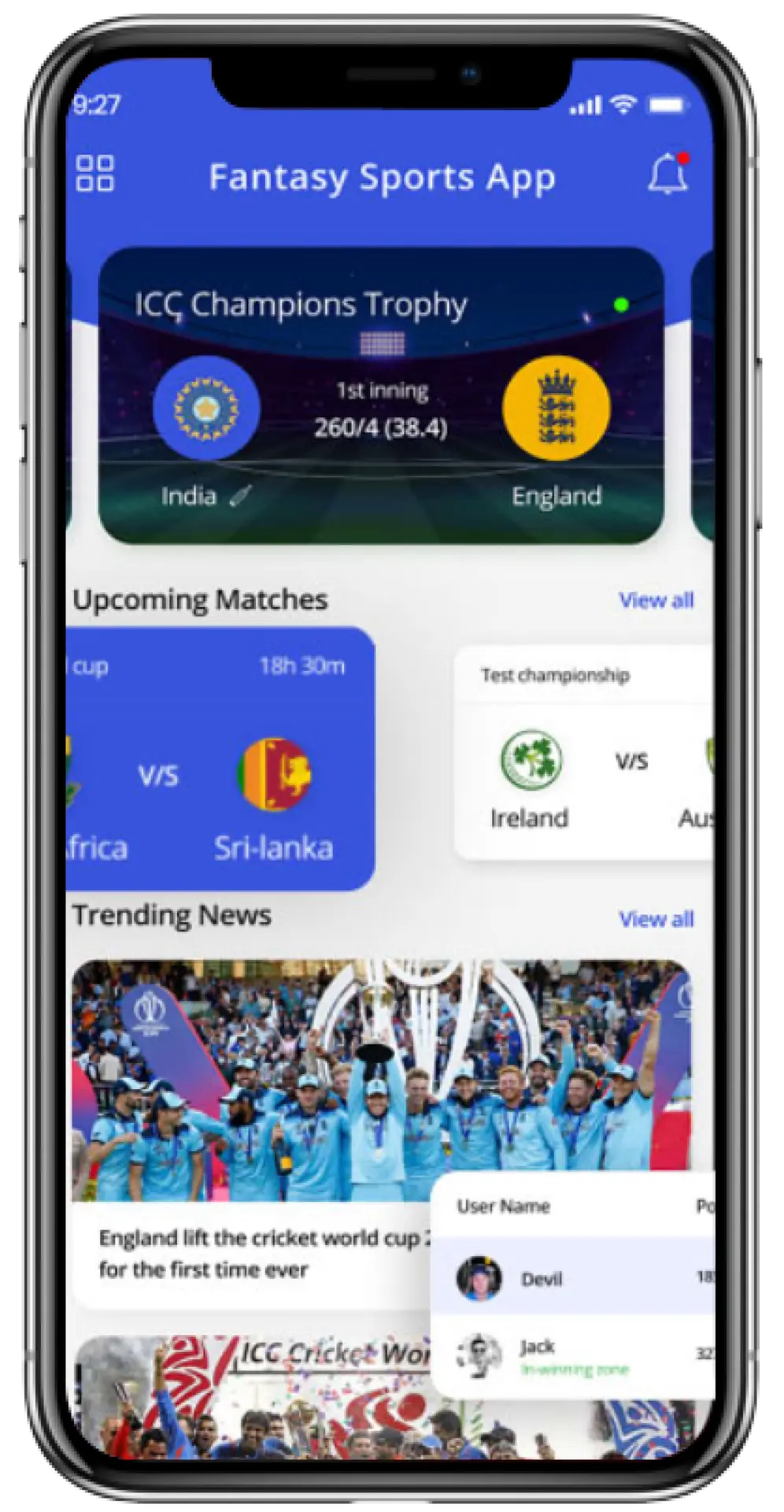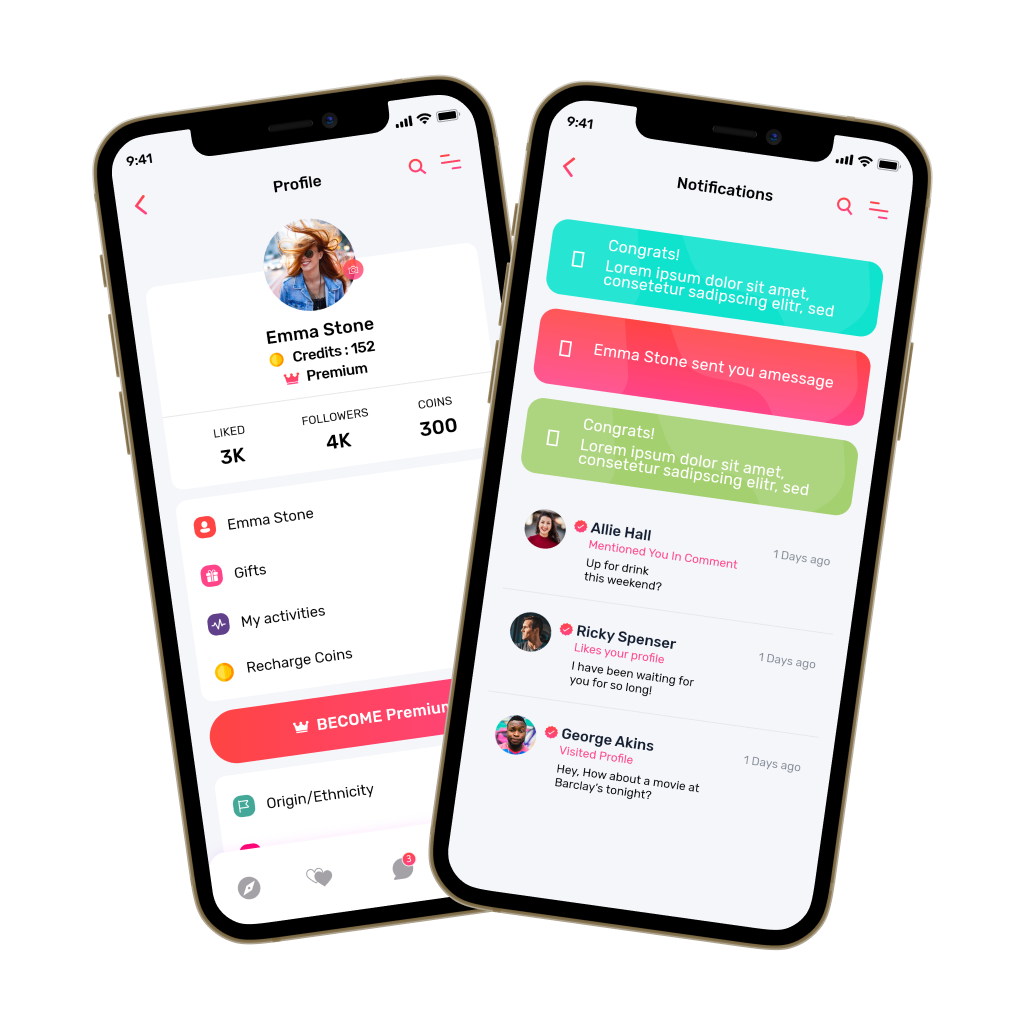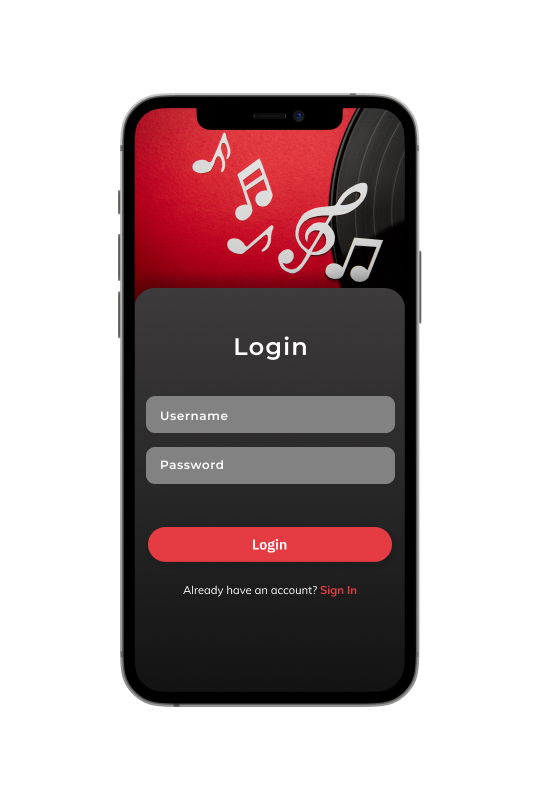Music has become an essential part of daily life, yet many platforms fall short with fragmented libraries, slow streaming, and limited personalization. A well-designed music streaming app fixes these issues, offering instant access to vast catalogs, curated playlists, and tailored recommendations for an effortless, enjoyable listening experience.
These modern music streaming apps do more than just play songs. AI-powered recommendations, offline access, social sharing, and high-quality audio make listening engaging and interactive. Cloud infrastructure, microservices, and robust APIs ensure smooth, scalable performance across devices.
In this blog, we explain how to build a standout music streaming app by looking at key features, the tech stack, and monetization. With IdeaUsher’s expertise, you’ll get practical steps and insights to turn your idea into a successful music app.
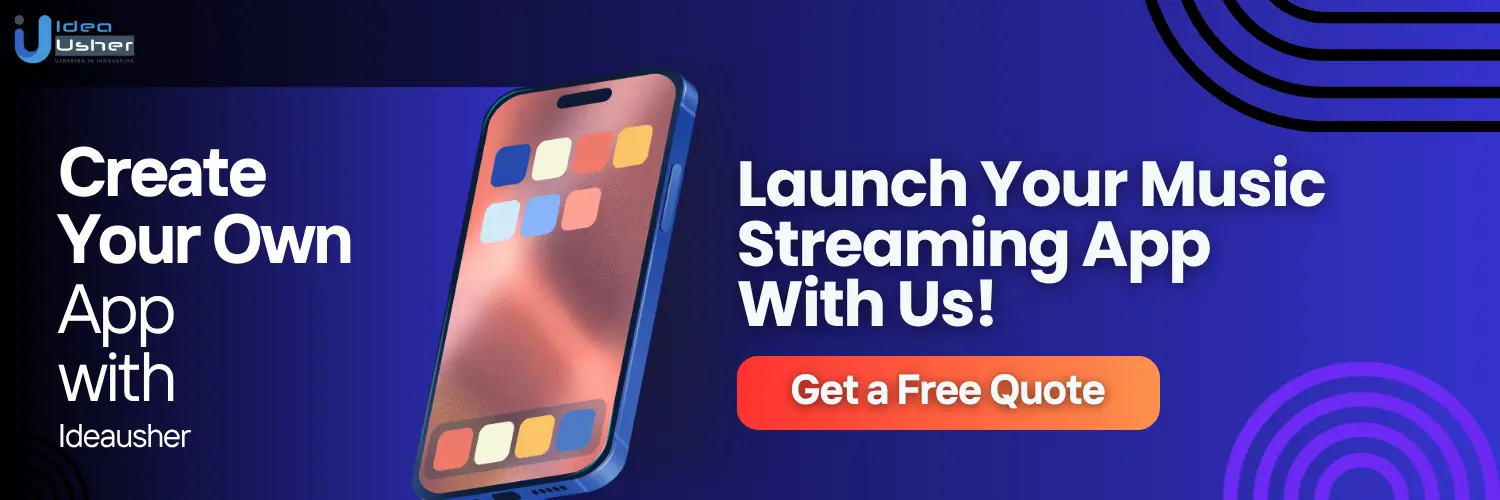
Understanding Music Streaming Apps
A music streaming app is a digital platform that allows users to access songs, podcasts, and other audio content instantly via the cloud without storing files locally. They use cloud infrastructure, adaptive audio, and recommendation systems to provide a smooth experience. As the market evolves, users now expect more convenience, personalization, and value from these services.
- Personalized recommendations based on listening history, moods, and activities.
- Instant access to large music libraries covering global and regional content.
- High-quality audio streaming with adaptable bitrates for different networks.
- Cross-platform sync across mobile, web, smart TV, and wearables.
- Social listening features like shared playlists and collaborative sessions.
- Offline mode for users who travel or prefer low data usage.
- Non-intrusive monetization through fair subscription models or minimal ads.
- Creator-focused features including artist pages, direct fan engagement, and exclusive content.
Types of Music Streaming Apps
Understanding the different types of music streaming apps helps you identify which model best aligns with your product vision and target audience.
| Type of App | Description | Example |
| On-Demand Music Streaming Apps | Allow users to search, play, and create playlists from an extensive music library anytime. | Apple Music |
| Live Radio Streaming Apps | Stream live radio stations, talk shows, news, and DJ-hosted programs. | iHeartRadio |
| Cloud-Based Music Storage Apps | Enable users to upload personal music collections to the cloud and stream across devices. | YouTube Music (Music Locker Feature) |
| Podcast & Audio Content Platforms | Focus on podcasts, interviews, stories, and non-music audio content. | Audible |
| Artist-Centric / Fan-Based Streaming Apps | Offer exclusive artist content, direct fan subscriptions, and early releases. | Bandcamp |
| Genre-Specific Music Apps | Target listeners of specific genres such as classical, jazz, or meditation music. | Calm |
How Is the $53.7B Music-Streaming Market Growing 12.5% Annually?
The global music streaming market size was estimated at USD 46.66 billion in 2024 and is projected to reach USD 108.39 billion by 2030, growing at a 14.9% CAGR from 2025 to 2030. This rapid expansion highlights the increasing shift from traditional music consumption to digital-first, on-demand listening across all age groups and device types.

Business of Apps reports that music-streaming apps generated ~$53.7B in 2024, showing a strong 12.5% year-over-year increase, driven by subscription upgrades, ad-growth, and hybrid monetization models.
Why the Current Market Still Welcomes New Music-Streaming Apps?
Despite dominant global players, the streaming industry is far from saturated. Multiple factors show that new entrants can still succeed and scale:
- User Growth in Emerging Regions Is Accelerating: Markets like MENA, Sub-Saharan Africa, and Latin America are growing 20%+ YoY, with rising smartphone usage bringing millions of new streamers into the ecosystem.
- Youth Engagement Continues to Rise: Users aged 13–24 account for over one-third of all streaming, showing the highest daily activity and strong interest in new formats like social discovery and AI-driven playlists.
- Hybrid Monetization Models Are Expanding: Freemium tiers, ads, micro-payments, and VIP upgrades make onboarding easier. With multi-app usage now common, new platforms can attract users without replacing existing ones.
- High Retention Through Personalization: Once users create playlists or libraries, retention increases sharply. Personalized recommendations and mood-based listening give new apps a strong opportunity to build loyalty.

High-Potential Emerging Trends New Apps Can Leverage
These trends are not just ideas. Real, well-funded platforms are already being built in these areas. New apps can learn from them, compete with them, or even work together.
1. Blockchain-Powered Streaming & Artist Monetization:
Example: Audius, a decentralized music protocol that lets artists retain control and earn more. They raised $5.5 M in Series A from top VCs (General Catalyst, Lightspeed, Pantera, Kleiner Perkins).
Audius enables transparent payments, artist governance, and token-based monetization, which aligns with the trend of direct, fairer artist economics.
2. AI-Powered Sound & Wellness:
Example: Endel creates AI-generated, adaptive soundscapes for focus, sleep, and relaxation. They raised $15 M in Series B, led by Waverley Capital and True Ventures.
Their technology adapts to user context (time of day, location, heart rate, weather), showing how wellness + music can merge deeply with AI.
3. AI Music Creation & Generation Tools
Example: Udio, founded by ex-Google DeepMind researchers. As of now, they have raised $10 M in seed funding (backed by a16z, will.i.am, Common, UnitedMasters).
Udio lets users create up to 600 songs each month for free. This approach makes AI music creation accessible to everyone and sets Udio apart from other platforms.
What This Means for New Streaming App Creators
A new entrant today can succeed because:
- The market is growing, not shrinking
- The user base is expanding, especially young and emerging-market audiences
- The technology landscape is shifting, opening space for innovative features
- Big players cannot adapt quickly to every emerging trend
This means launching a streaming app now is not only possible, but also well-timed. Businesses can enter the market today and improve their app with AI, blockchain, and immersive audio to catch the next wave of streaming growth.
Key Features to Integrate in a Music Streaming App
The success of music streaming app development depends on features that balance user experience and technical performance. Core functionalities like personalized discovery and reliable playback must work seamlessly to build an engaging, scalable music ecosystem.

1. User Registration and Profiles
A smooth registration process is crucial for onboarding users quickly. Our developers focus on creating user profiles that store listening history, favorite tracks, and personalized preferences. This feature allows users to enjoy a tailored experience while keeping their data organized.
2. Extensive Music Library
A rich and diverse music library forms the backbone of any streaming app. Users should be able to explore songs by genre, artist, album, or mood. Our approach ensures the library is structured, easy to navigate, and continuously updated to keep content fresh and engaging.
3. Playlists & Favorites
The ability to create and manage playlists is essential for personalized listening. Users can save favorite tracks, organize playlists by mood or occasion, and share them with friends. This feature increases user engagement by encouraging interaction with the app and personal content curation.
4. High-Quality Streaming & Offline Mode
Seamless playback is a non-negotiable feature for music apps. We focus on delivering high-quality streaming while minimizing buffering. Additionally, offline listening allows users to enjoy music without internet connectivity, ensuring the app remains functional in any situation.
5. Personalized Recommendations
Personalization keeps users engaged over time. Our developers integrate recommendation engines that suggest tracks based on listening habits, liked songs, and trending music. This makes the app feel tailored to each individual, enhancing user satisfaction and retention.
6. Search & Discovery
Efficient search functionality helps users find music quickly. Advanced filters, trending lists, and genre-based recommendations make discovery easy and enjoyable. A strong search feature ensures users spend more time exploring music rather than struggling to locate it.
7. Social Sharing & Interaction
Music is inherently social, so integrating sharing features adds value. Users can share playlists or favorite tracks on social media platforms, follow friends, and explore their activity. This feature not only drives engagement but also helps grow the app’s user base organically.
8. Security & Privacy Controls
User trust is paramount. Our developers prioritize secure logins, encrypted data, and clear privacy settings. Users should feel confident that their personal information and listening data are protected, which builds long-term loyalty and credibility for the app.
Advanced Key Features for a Music Streaming App
These advanced features take your music streaming app beyond the basics, enhancing user engagement, personalization, and overall experience.
- AI-Powered Recommendations and Mood Playlists: Dynamic playlists and personalized suggestions based on listening patterns, time of day, and user moods.
- Collaborative Playlists: Users can create and edit playlists with friends in real time, encouraging social interaction and engagement.
- Live Streaming & Radio Channels: Exclusive artist sessions, concerts, or curated radio channels for a more immersive and immediate music experience.
- Podcast & Non-Music Audio Integration: Host podcasts, audiobooks, and other audio content to attract a wider audience and increase daily engagement.
- Advanced Search & Discovery: Smart filters, trending charts, and context-based suggestions for effortless discovery of new artists, genres, and releases.
- Offline Downloads with Smart Management: Intelligent offline functionality with auto-updates and storage management for uninterrupted listening.
- Analytics and Listening Insights for Users: Personalized stats such as top artists, favorite genres, and listening trends to gamify and enhance engagement.

Development Process of a Music Streaming App
We design music streaming app development strategies that seamlessly blend user experience with robust functionality. Our approach combines creative vision with technical precision to deliver apps that are scalable, secure, and tailored to audience needs.
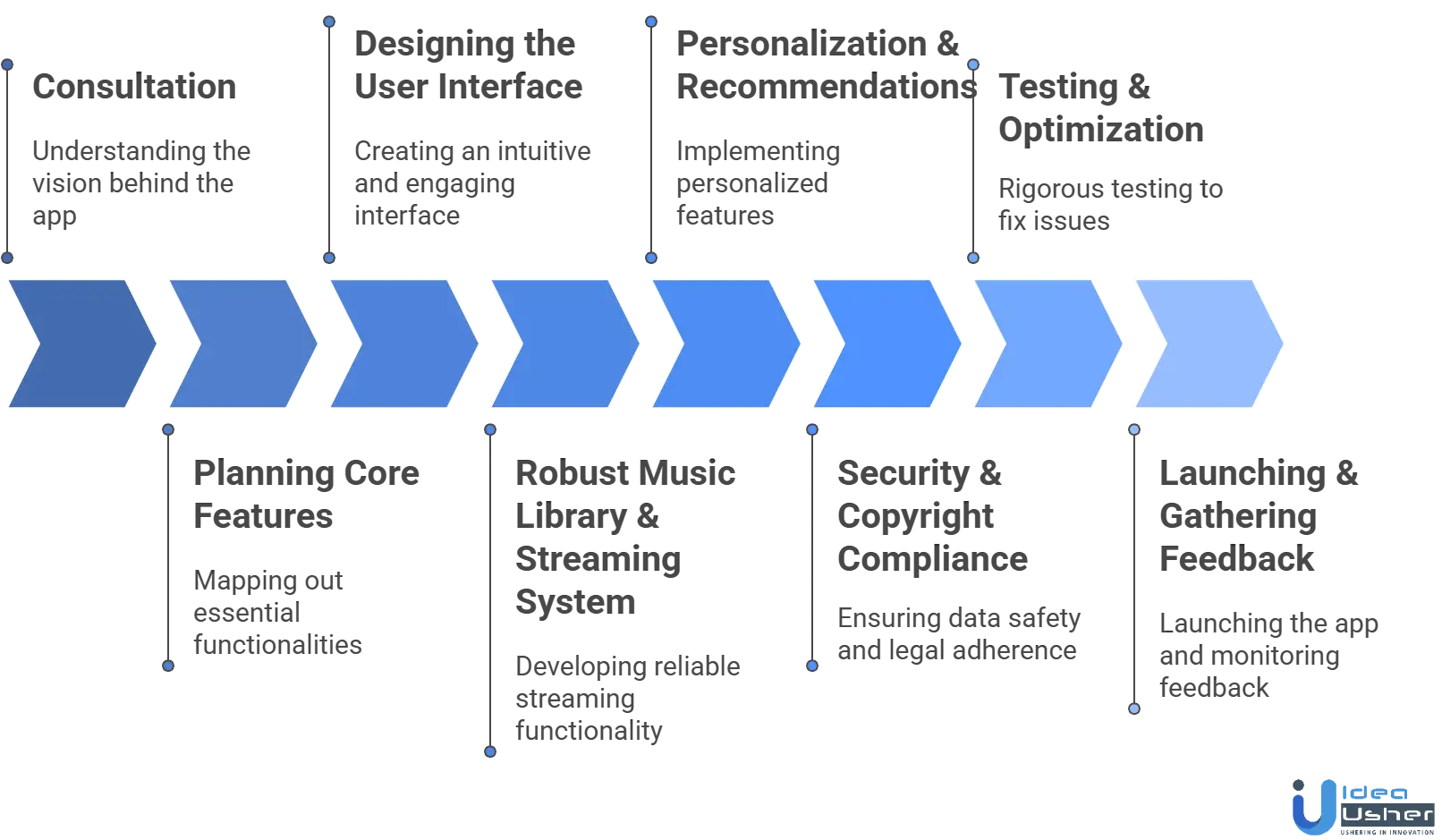
1. Consultation
Our developers start by understanding the vision behind the music streaming app. We define the type of music experience we want to deliver and identify our target audience. This allows us to focus on features and design choices that cater specifically to our users’ preferences, ensuring the app resonates with them from day one.
2. Planning Core Features
We carefully map out the essential features that will make the app functional and appealing. From user registration and playlist creation to offline listening and social sharing, we make sure every feature serves a clear purpose. Planning this in advance streamlines development and helps us avoid unnecessary revisions later.
3. Designing the User Interface
Our developers collaborate closely with designers to create an intuitive and engaging interface. We focus on smooth navigation, clean layouts, and interactive elements that make discovering and playing music effortless. A well-designed UI ensures users enjoy every interaction with the app.
4. Robust Music Library & Streaming System
We develop a reliable music library and streaming functionality that can handle a large volume of tracks without interruptions. Our goal is to provide seamless playback, high-quality streaming, and minimal buffering, ensuring users can enjoy music anytime, anywhere.
5. Personalization & Recommendations
To keep users engaged, we implement personalization features such as customized playlists, recommended tracks, and mood-based suggestions. Our developers use intuitive algorithms to ensure that each user’s experience feels unique and tailored to their musical tastes.
6. Security & Copyright Compliance
We prioritize the safety of user data and legal compliance. Our developers implement secure login systems, protect personal information, and ensure that all music content is fully licensed. This approach safeguards both our users and the app from potential legal or security issues.
7. Testing & Optimization
Before launch, our team conducts rigorous testing to identify and fix any performance or usability issues. We optimize the app to prevent crashes, improve load times, and ensure smooth streaming. This phase is crucial to delivering a polished and reliable app experience.
8. Launching & Gathering Feedback
Once the app is ready, we launch it and actively monitor user feedback. Our developers analyze user behavior and reviews to make iterative improvements. Continuous updates based on real user insights help us keep the app competitive and aligned with user expectations.
Cost to Develop a Music Streaming App
Estimating the budget for a music streaming app is crucial for aligning your project with its goals and resources. Understanding how development costs are allocated across each stage allows for efficient planning and confident investment.
| Development Phase | Description | Estimated Cost |
| Consultation | Initial discussions, requirement gathering, and defining the project vision and scope. | $5,000 – $8,000 |
| Core Features | Structuring features, user flows, app architecture, and overall development roadmap. | $6,000 – $10,000 |
| Designing the User Interface | Crafting UI/UX layouts, navigation flow, wireframes, and visual design elements. | $15,000 – $32,000 |
| Music Library & Streaming System | Developing scalable music management, audio delivery systems, and real-time streaming functionality. | $18,000 – $35,000 |
| Personalization & Recommendations | Implementing customized playlists, user behavior tracking, and intelligent music suggestions. | $12,000 – $20,000 |
| Security & Copyright Compliance | Integrating secure authentication, data protection, and licensing compliance mechanisms. | $8,000 – $15,000 |
| Testing | Performance tuning, bug resolution, device testing, and user experience refinement. | $8,000 – $14,000 |
| Deployment & Post-Launch | Deployment, user onboarding support, monitoring insights, and preparing for future updates. | $5,000 – $12,000 |
Total Estimated Cost: $50,000 – $130,000
Note: Cost ranges can vary based on feature complexity, AI Integration, UI depth, licensing, geographic rates, and scalability needs. Integrations, upgrades, or customizations can also impact the budget.
Consult with IdeaUsher to get a tailored cost estimate and a detailed roadmap for building a high-performing music streaming app designed around your vision, audience, and growth goals.

Revenue Models of a Music Streaming App
A successful music streaming platform uses a mix of monetization models to balance user accessibility and long-term profitability. Below are the core revenue streams used by leading apps like Spotify, YouTube Music, Apple Music, and Anghami.

1. Freemium Model (Ads-Supported Tier)
Users can enjoy the core features of the app at no cost, while the platform earns revenue through integrated advertisements.
How it works:
- Users listen to music with periodic audio or video ads inserted between tracks.
- The app features banner ads, interstitial ads, and sponsored playlists within the interface.
- Advertisers pay the platform based on impressions, clicks, or overall engagement with their ads.
Why it works:
- Makes it easy to attract a large number of users without any upfront barrier.
- Over time, many free users upgrade to premium plans to enjoy an ad-free experience.
2. Premium Subscription Plans
Subscription-based revenue remains the core of most music streaming platforms, offering users an ad-free and enhanced listening experience.
Popular plans include:
- Individual monthly plan for single users.
- Family plan allowing multiple profiles under one account.
- Student plan offered at a discounted rate.
- Annual plan providing long-term access at reduced pricing.
- Premium Duo designed for two members living at the same address.
Benefits to the platform:
- Generates predictable and recurring monthly income.
- Increases ARPU (Average Revenue Per User) across all user segments.
- Ad-free streaming and premium features improve user satisfaction and retention.
3. Fan-Based Monetization
Users subscribe directly to their favorite artists for access to exclusive content, creating a more personal and immersive fan experience.
Includes:
- Early song releases available only to subscribed fans.
- Behind-the-scenes content such as studio sessions or creative process clips.
- Exclusive livestreams and virtual concerts hosted by the artist.
- Private fan communities where artists can interact more closely with supporters.
Inspired by: Patreon-style creator subscriptions, Apple Music’s artist channels, and Spotify’s Fans First initiatives.
4. Sponsored Playlists & Brand Partnerships
Brands collaborate with the platform to sponsor curated playlists, allowing them to reach highly targeted listener segments in a subtle, engaging way.
Examples:
- Fitness playlists sponsored by sports or athletic brands like Nike.
- Mood-based playlists backed by beverage or lifestyle brands.
- Festival or event playlists promoted by telecom or entertainment companies.
Why it works: Brands are willing to pay premium rates because sponsored playlists often have high listen-through and engagement levels, making them an effective advertising channel.
Emerging Technology Trends in Music Streaming for 2025
Emerging technologies are rapidly reshaping how listeners discover, interact with, and experience music. As innovation accelerates, these trends are setting the stage for the next generation of music streaming platforms in 2025 and beyond.
1. Generative AI for Music Creation
Generative AI is enabling users and artists to create full songs with simple prompts. Platforms like Suno already support instant AI-generated tracks, while models such as ReaLJam allow real-time collaboration between humans and AI, opening new creative workflows.
2. AI-Powered Contextual Recommendations
Recommendations are becoming more mood- and context-aware. Tools like Deezer’s Text2Playlist use natural language to generate playlists, and evolving voice assistants such as Alexa are making music discovery more conversational and personalized.
3. AI-Content Detection & Anti-Fraud Systems
As AI music expands, platforms are adding tools to detect and label synthetic content. Deezer tags AI-generated tracks and blocks fraudulent streams, helping preserve artist payouts and platform trust.
4. Immersive Audio & Spatial Sound
Spatial audio formats like Dolby Atmos and 360 Reality Audio are gaining traction, offering richer listening experiences. Major platforms including Apple Music, Amazon Music, and Tidal already support large libraries of immersive audio tracks.
5. Blockchain & Smart Contracts
Blockchain is transforming how artists monetize music, offering transparent payouts and new revenue models. Audius uses decentralized streaming to pay creators directly, while Royal lets fans buy fractional song ownership and earn from royalties.
6. Real-Time Human-AI Music Collaboration
New AI models are enabling live co-creation with musicians. Technologies like ReaLJam respond to musical cues in real time, turning AI into an interactive creative partner rather than a post-production tool.
Conclusion
Developing a successful platform requires a clear understanding of user needs, seamless design, and robust technology. Music streaming app development focuses on delivering high-quality audio, personalized recommendations, and smooth navigation. By integrating features like playlists, offline access, and social sharing, developers can create an engaging and intuitive experience that keeps listeners coming back. Attention to scalability, security, and performance ensures the app can handle growing audiences while maintaining reliability. A well-planned approach to music streaming app development transforms an idea into a dynamic platform that resonates with users and stands out in a competitive market.
Why Choose IdeaUsher for Music Streaming App Development?
At IdeaUsher, we specialize in music streaming app development that delivers seamless audio experiences, personalized recommendations, and intuitive interfaces. Our team combines expertise in cloud streaming, mobile frameworks, and AI-driven features to build apps that keep listeners engaged.
Why Work with Us?
- Custom App Solutions: We design apps tailored to your brand and audience, ensuring high engagement and retention.
- Advanced Technology: Our apps leverage cloud storage, streaming servers, and AI-based personalization for superior user experiences.
- Proven Track Record: We have successfully launched scalable music streaming platforms that handle large user bases reliably.
- Security and Performance: Our solutions ensure secure streaming, smooth playback, and fast content delivery across devices.
Explore our portfolio to see how we have helped global brands launch impactful music streaming apps.
Reach out today for a free consultation, and let us help you develop a dynamic music streaming app that resonates with users.
Work with Ex-MAANG developers to build next-gen apps schedule your consultation now
FAQs
Key features include personalized playlists, offline listening, high-quality audio, search and recommendation engines, and social sharing. These features enhance user engagement, make content discovery seamless, and ensure a competitive experience in the music streaming market.
The cost depends on app complexity, platform choice, and features. Basic apps can start around $50,000, while fully-featured, scalable solutions with advanced recommendations and social integration may exceed $150,000.
Music streaming apps typically use cloud storage, streaming servers, APIs for music libraries, databases for user management, and frameworks like React Native or Swift for mobile app development. AI can enhance recommendations and personalization.
A smooth experience relies on intuitive UI, fast loading times, minimal buffering, personalized recommendations, and easy navigation. Continuous testing and optimization for different devices also ensure reliability and high user satisfaction.
